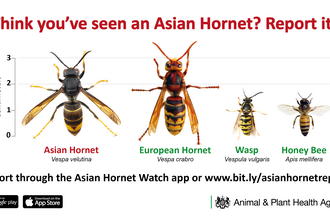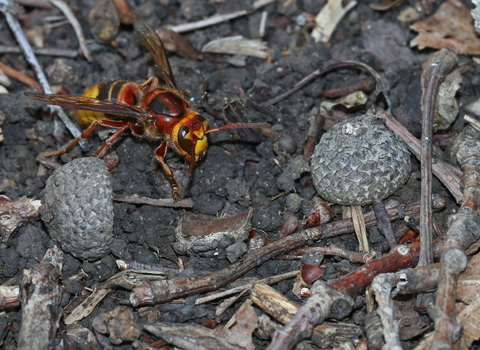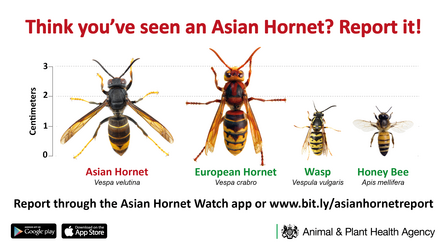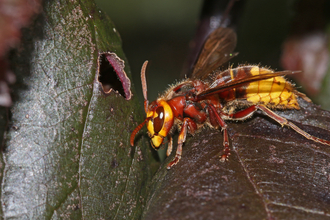We have one native hornet in Worcestershire, the European hornet. We're also home to a number of insects that look like hornets and you can find more information about them below. Do let us know if you spot any of these via our short Wildlife Sightings form.
We're encouraging everyone to become more familiar with our hornets and their look-a-likes so that should anyone spot an Asian hornet in Worcestershire or beyond, they'll be able to report the sighting to the right people in good time.
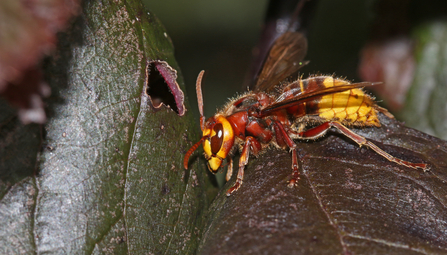
Hornet by Wendy Carter
European hornet (Vespa crabro)
- Larger than Asian hornets (about 3cm)
- Head yellow from front and reddish from above
- Abdomen mostly orange-yellow with black stripes
- Thorax and legs black/reddish brown
Our native hornets are rather docile with no interest in stinging us unless we really threaten them. You can learn more about these gentle giants in our humming hornets blog.
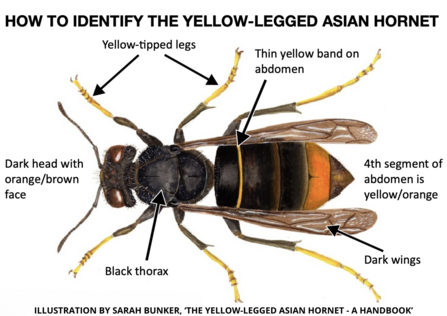
Asian hornet by Sarah Bunker 'The Yellow-legged Asian Hornet - A Handbook'
Asian hornet (Vespa velutina)
- Smaller than native hornets (about 2.5cm)
- Orange head from front and black from top
- Abdomen almost entirely dark, with fine yellow stripes and a yellow or orange 4th segment near the base
- Black or brown thorax
- Legs with yellow tips, like they've been dipped in paint
Asian hornets arrived in France in 2004, probably through imported goods. They were spotted for the first time in the UK in 2016 and the nest located and destroyed. Asian hornets seen in the southeast of England in spring 2024 indicate that some queen hornets from 2023 were able to hibernate. These non-native insects are a threat to the UK's native insects and honey bees; they're often spotted near bee hives as they prey on bees defending the hive, It is essential that any sightings of Asian hornets are reported.
When is a hornet not a hornet?
It's not just hornets that look like hornets. Some of our larger wasps do a pretty good job of appearing hornet-like and that's before we start looking more closely at insects that aren't related to them.
Mimicry is rife in the natural world - many species have cottoned onto the fact that if they can look like something that's much more dangerous then predators might leave them well alone.
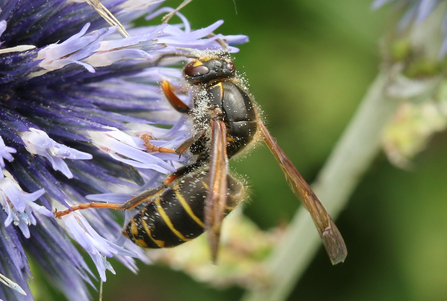
Median wasp by Wendy Carter
Median wasp Dolichovespula media
- Variable in colour but often darker than many wasps you'll encounter - even the darkest individuals have thin yellow bands on their abdomen
- Look for the 'tick' (or wide 'v') mark on the shoulder, near where the wings meet the body
- Face has a T shape between the eyes
- Queens can be similar to hornets but have a darker thorax with chestnut restricted to the rear rather than all over the thorax
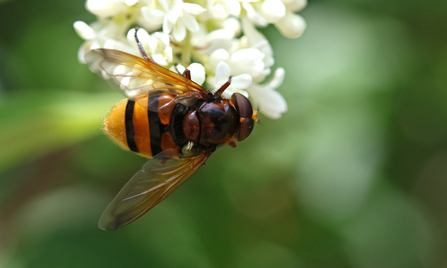
Hornet hoverfly by Wendy Carter
Hornet mimic hoverfly (Volucella zonaria)
- Chestnut/orange and brown/black bands on abdomen
- One pair of wings
- Antennae short and stubby
- Eyes large and round and prominently visible from above
- 'Waist' less defined than in wasps and hornets
- There is an additional species, the lesser hornet hoverfly (Volucella inanis) that is slightly smaller and more yellow than chestnut
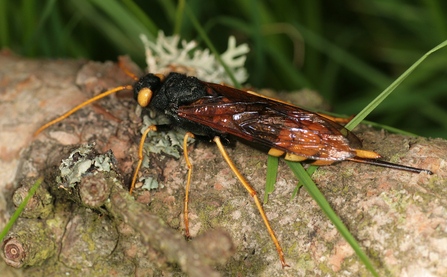
Giant horntail by Malcolm Storey
Giant horntail (Urocerus gigas)
- More elongate appearance than hornet (up to 4cm long)
- Females are yellow and black whereas males have red on their abdomen
- The proportionately smaller-looking head is black with a yellow patch on each side
- The end of the abdomen has a strong yellow spike - females also have a long ovipositor, which is used for laying eggs
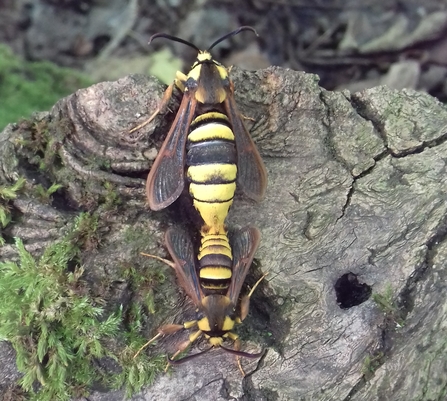
Hornet moths by Dominique Cragg
Hornet moth (Sesia apiformis)
- More yellow appearance than a hornet
- Furry body with two pairs of boldly-outlined wings
- Small eyes
- The similar lunar hornet moth (Sesia bembeciformis) has a black head and shoulder patches
